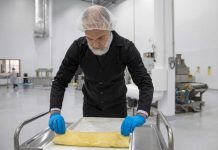
EVANSVILLE, Ind., March 1 (UPI) — Meat that’s been grown in a laboratory — not raised in a farmyard — might begin to appear on restaurant menus and at meat counters around the world in 2019.
“We hope to make our first sale this year,” said Andrew Noyes, a spokesman for the company Just, based in San Francisco, which is developing a lab-grown chicken product. “We are creating real meat in our facility that doesn’t require the capture or slaughter of animals.”
Other companies are making similar claims.
A California startup, Finless Food, is creating a lab-grown tuna. Another California company, Memphis Meats, is working on other cell-based products. And similar companies have emerged in countries like Spain, Israel and the Netherlands.
The race seems to be on for these companies to be the first to use emerging cell-based meat science to commercially sell lab-grown meat.
These businesses are making some lofty claims. They promise to reinvent meat production, and offer consumers a way to consume meat without killing animals. This makes their products more humane, they say. It also would be more ecologically friendly and sustainable.
“The reality of population growth is we’re not going to be able to feed the world in conventional ways,” Noyes said. “Our CEO decided if we wanted to fulfill our ultimate mission of helping everyone eat well and solving problems in the food system, we can’t do that without looking at a [lab-grown] meat.”
But as these companies vie for public attention — and investment — scientists urge caution. Little is known about the processes by which businesses are growing these meats — because much of the science they’re using is considered proprietary intellectual property.
That means that the sudden rush toward commercial production has left scientists, government agencies and the meat industry ill prepared to understand these new products — or regulate them.
“Is it meat or is it not meat?” Dale Woerner, an associate professor of sustainable meat science at Texas Tech University, asked rhetorically. “The message I would give you is, we don’t know.
Meat scientists around the country have tried to study these products, Woerner said. So far, they’ve been denied access.
“We are theorizing what it is and what it could be,” he said. “But without a tangible, measurable product, there is no way for us to say whether it is or not. The consensus from the scientific community is we cannot make a determination without actually having the product to evaluate.”
That also means that scientists don’t know if the products are safe to eat.
“I’m not saying they’re not safe. I’m saying I don’t know,” said Dustin Boler, an associate professor of meat science and muscle biology at the University of Illinois. “My thoughts are we need to be open- minded, but we need to put this through the rigor of independent scientific evaluation.”
This lack of information is problematic on several fronts, said Boler and Woerner, who are members of the American Meat Science Association’s board of directors.
At the most basic level — no one’s sure what to call it.
The companies developing the products are clear: They say they are growing meat. “It’s animal protein,” Noyes said. “It’s real meat.”
But many in the conventional meat industry disagree — strongly.
“Meat comes from critters that wander around on the earth and do things,” said Will Rogers, a spokesman for the American Farm Bureau Federation. “These products are produced in labs in an artificial environment. It would be completely wrong to say it is the same thing. We want to make sure consumers are not confused.”
The debates don’t stop there.
The federal government is struggling to decide which agency should regulate these products. The U.S. Department of Agriculture traditionally oversees most commercially produced meat products, while the Food and Drug Administration overseas game and processed meats.
The agencies announced in November a plan to share regulatory power, but the details of those regulations still are being worked out.
With the promise of commercially available cell-based meat on the horizon — and federal regulations still unclear — multiple state governments are taking matters into their own hands.
In August, Missouri became the first state to define meat as edible portions of livestock or poultry. If it didn’t come from a live animal, it can’t be labeled meat.
Several other states proposed similar laws this year, including North Dakota, Kentucky and Indiana.
“We know we don’t want it to say beef, because it’s not,” said Joe Moore, the executive vice president of the Indiana Beef Cattle Association, which supported the Indiana bill. “I use the term ‘Frankenmeat.’ Truth in labeling, that’s all we’re asking for. The consumer should know what’s what, and the consumer can make his own choice about what they want.”
But neither the controversy nor the lack of scientific research has stopped investors and advocacy groups from pouring millions into developing this technology.
In January 2018, meat industry giant Tyson Foods invested heavily in Memphis Meats. Other large food corporations, including Cargill, have made similar investments.
And some in the scientific community are also dipping their toes in. At the University of Toronto’s Protein Structure and Function Lab, Peter Stogios is researching ways to grow cultured cells more cheaply.
The basic process for growing meat in a lab begins with cells from a host animal, Stogios said.
“Then you have a chamber with controlled oxygen and carbon dioxide levels and is sterile,” said Stogios, a senior associate researcher.
“You don’t want the cells to die from bacteria in the environment. Then you add what’s called growth media, which are vitamins, minerals and hormones — all the things cells need that we get from food.”
What ends up growing does not resemble a traditional cut of animal meat. The product appears more like ground or minced meat.
“The stage all companies are at is they’re able to grow a kind of minced meat that’s good for making sausages, chicken nuggets and hamburger patties,” Noyes said. “It is an unstructured material. We [can’t] grow muscle and fat around bone.”
The process is expensive — too expensive for these products to be widely sold. At least for now.
“We haven’t disclosed cost because the cost is going down,” Noyes said. “I wouldn’t say it’s cheap.”





